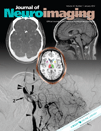Endovascular Revascularization of Chronic Symptomatic Vertebrobasilar Occlusion
J Neuroimaging 2012;22:74-79.
Abstract
ABSTRACT
BACKGROUND AND PURPOSE
Acute basilar artery occlusion is associated with a high risk of stroke, mortality, and poor outcome in survivors. Timely vessel revascularization is critical to improve the clinical outcome in this condition. A subset of patients survives acute occlusion with mild or no disability and some of these individuals develop recurrent ischemic events despite optimal medical therapy. The strategy for management of these patients is unknown.
CASE SUMMARY
We described 3 patients with chronic intracranial vertebrobasilar occlusions who presented with recurrent ischemic symptoms and progressive disability. All 3 patients were treated successfully with angioplasty and stenting. One patient experienced headache postprocedure and was found to have subarachnoid hemorrhage, which was self-limiting without need for intervention or result in permanent neurological sequela. All 3 patients have been free of recurrent symptoms for up to 30 months.
CONCLUSIONS
Revascularization of chronic vertebrobasilar occlusions is technically feasible. Due to the high-risk nature, it should be reserved as an option only for selected group of patients with recurrent ischemic symptoms and progressive disability despite maximal medical therapy. Further prospective study is helpful to clarify the role of this intervention.




